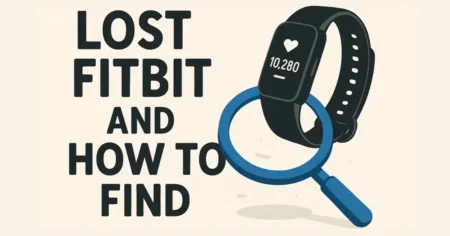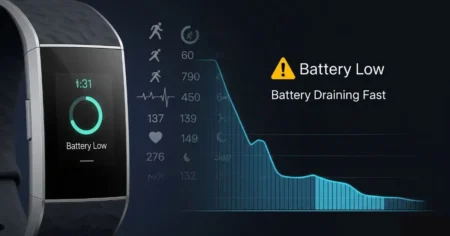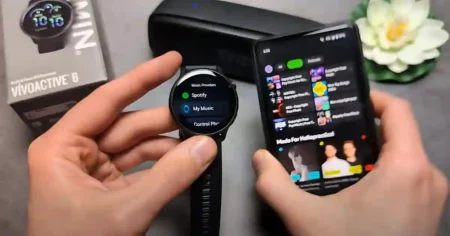Have you ever felt frustrated when you realized that your Fitbit Not Tracking Steps accurately? It can be discouraging to put in the effort to lead an active lifestyle, only to be let down by your fitness tracker.
But fear not! In this article, we will explore some common reasons why your Fitbit may not be tracking steps and provide you with practical solutions to fix the issue. So, let’s dive in and get those steps counted accurately!
How Fitbit Tracks Your Steps
Before we dive into troubleshooting, let’s quickly understand how Fitbit tracks steps. Fitbit devices usually use an accelerometer to detect your movement patterns.
This device measures acceleration and can distinguish between different types of motion, such as walking, running, or climbing stairs. By analyzing this data, Fitbit calculates the number of steps you’ve taken throughout the day.
Common Issues and Fixes Fitbit Not Tracking Steps
1. Ensure Proper Wearing
One common reason for inaccurate step tracking is improper wearing of your Fitbit device. Make sure you are wearing it securely on your wrist and that it fits snugly.
If your Fitbit has a heart rate monitor, ensure that it is in contact with your skin and not covered by clothing or loose straps.
2. Check Device Placement
Sometimes, the placement of your Fitbit device can affect its ability to accurately track steps. Ensure that the device is positioned correctly on your wrist, with the display facing upwards. Avoid wearing it too loose or too tight, as this can interfere with its ability to detect your movements accurately.
3. Calibrate Your Fitbit
Calibrating your Fitbit can help improve step-tracking accuracy, especially if you notice significant discrepancies. To calibrate, start by measuring your stride length manually. Take 20 steps and measure the distance covered.
Then, open the Fitbit app on your smartphone, go to the Account tab, select your device, and find the option to set your stride length. Enter the measured value, save it, and your Fitbit should now provide more accurate step tracking.
4. Restart Your Fitbit
When facing any technical issues, a simple restart can often solve the problem. Here’s how you can restart your Fitbit:
- Plug your charging cable into a USB port.
- Press and hold the button on your Fitbit for 10-15 seconds.
- Release the button and unplug the charging cable.
- Wait for a few seconds and then press the button again to turn on your Fitbit.
5. Update Firmware and App
Outdated firmware or app versions can sometimes lead to step-tracking issues. To ensure your Fitbit is running smoothly, check for any available firmware updates and install them.
Similarly, update the Fitbit app on your smartphone to the latest version from the respective app store. These updates often include bug fixes and improvements that can resolve tracking problems.
6. Avoid Irregular Movements
Fitbit relies on motion patterns to accurately track steps. Activities like pushing a stroller, pushing a shopping cart, or carrying something in your hands might not get counted as steps.
While these activities contribute to your overall physical activity, they may not reflect in your step count. Incorporating vigorous wrist movements while doing such activities might help improve accuracy.
7. Battery and Power Issues
If your Fitbit has a low battery, it may not track steps correctly. Ensure that your device has enough power by charging it regularly.
Additionally, keep in mind that certain Fitbit models have a power-saving mode that can affect real-time step tracking. Check your device’s settings to verify that this mode is disabled.
Why Fitbit Charge 5 Not Tracking Steps?
If you’re encountering issues with your Fitbit Charge 5 not tracking steps accurately, there are several troubleshooting steps you can try to resolve the problem.
Here’s a comprehensive guide to help you get your Charge 5 back on track and accurately monitor your steps:
1. Check Fitbit Charge 5 Firmware:
Ensure your Fitbit Charge 5 is running the latest firmware version. Outdated firmware can lead to various glitches and performance issues, including inaccurate step tracking. To check for updates, connect your Charge 5 to the Fitbit app and navigate to the “Device Settings” section. If an update is available, follow the on-screen instructions to install it.
2. Calibrate Your Fitbit Charge 5:
Calibrating your Charge 5 helps ensure it accurately measures your stride length, which is crucial for accurate step counting. To calibrate your Charge 5:
- Open the Fitbit app.
- Tap on your Charge 5 tile.
- Select “Exercise Settings.”
- Choose “Stride Length.”
- Follow the on-screen instructions to calibrate your stride length.
3. Clean Your Fitbit Charge 5 Sensor:
The Fitbit Charge 5 sensor can accumulate dirt, sweat, and dust, which can interfere with its ability to detect arm movements and track steps accurately. Clean the sensor gently with a damp cloth to remove any buildup.
4. Restart Your Fitbit Charge 5:
A simple restart can often resolve minor glitches that may be causing inaccurate step tracking. To restart your Charge 5, hold down the side button until the device powers off. Then, press and hold the same button until the Fitbit logo appears.
5. Check Fitbit Charge 5 Wearing Position:
Ensure you’re wearing your Charge 5 snugly on your non-dominant wrist. The band should be tight enough that it doesn’t move around, but not so tight that it’s uncomfortable. Improper wearing can affect the sensor’s ability to detect arm movements accurately.
6. Check Fitbit Charge 5 Permissions:
Verify that the Fitbit app has the necessary permissions to access your activity data. On your smartphone, navigate to the app settings and grant the Fitbit app permission to access your physical activity data.
7. Reset Your Fitbit Charge 5:
If the aforementioned steps fail to resolve the issue, consider resetting your Charge 5 to factory settings. This will erase all data and settings, so make sure you have a backup. To reset your Charge 5, navigate to the device’s settings and select the reset option.
8. Contact Fitbit Customer Support:
If none of the troubleshooting steps have been successful, it’s time to reach out to Fitbit’s customer support team. They can provide further assistance and guide you through more advanced troubleshooting techniques.
Conclusion
Accurate step tracking is essential to staying motivated and achieving your fitness goals. If you’ve been experiencing issues with your Fitbit not tracking steps, try implementing the troubleshooting steps mentioned above.
Remember to wear your Fitbit correctly, calibrate it, and keep it updated. By following these simple fixes, you’ll soon regain confidence in your Fitbit’s step-tracking accuracy and continue on your fitness journey with renewed enthusiasm.
You may also like:-
Q. How to Fix a Fitbit Not Tracking Steps Properly
The Fitbit fitness tracker is a popular device that can track your steps, heart rate, and sleep. However, sometimes Fitbits can stop tracking steps accurately. If you are having this problem, there are a few things you can do to fix it.
Restart your Fitbit.
Make sure you are wearing your Fitbit correctly. It should be worn snugly on your non-dominant wrist.
Check your Fitbit’s software version. Outdated software can sometimes cause problems with Fitbits.
Calibrate your Fitbit. This ensures that the device accurately measures your stride length.
Clean your Fitbit sensor. Sweat, dirt, and dust can accumulate on the sensor and interfere with its ability to detect arm movements.
Reset your Fitbit. This will erase all data and settings, so make sure you have a backup.
If the above steps do not work, you may need to contact Fitbit customer support. They can help you troubleshoot the issue and determine if your Fitbit needs to be repaired or replaced.
Q. Why did Fitbit not track my steps?
There are various reasons why your Fitbit might fail to track your steps accurately. Here are some common causes of this issue:**
Incorrect Wearing of the Fitbit: It’s crucial to wear your Fitbit snugly on your non-dominant wrist for optimal step-tracking accuracy. If it’s too loose, it may struggle to detect arm movements.
Outdated Fitbit Software: Make sure your Fitbit is running the latest software version. Outdated software can lead to various glitches, including inaccurate step counting.
Incorrect Stride Length: Fitbit estimates your step count based on your stride length, which refers to the distance covered between two consecutive foot strikes. If your stride length is not set correctly, your step count will be inaccurate.
Dirty Fitbit Sensor: The sensor on your Fitbit can become clogged with sweat, dirt, and dust, hindering its ability to detect arm movements and accurately track steps.
Interference from Other Devices: Other electronic devices, such as smartwatches or heart rate monitors, can sometimes interfere with the Fitbit’s sensor, affecting step-tracking accuracy.
Hardware Issues: In some cases, hardware problems, such as a malfunctioning sensor or battery, can lead to inaccurate step tracking.







2 Comments
When I had the Fitbit ONE, I wore it on my waist and it tracked my treadmill steps perfectly. The reason that there are so many articles on why Fitbit devices are not tracking steps when on a treadmill is that the Fitbit watches do not do this. Discontinuing the ONE was truly a bad business decision and leaves FitBit openly vulnerable to any competitor who offers a stick type tracker similiar to the old FitBit One. I would switch in a second if another company did this because despite all of the wordy, BS explanations as to why the FitBit watches won’t track steps on a treadmill, the answer is that the watches cannot accurately do this – ever!
Thanks for sharing your experience! It’s true that the Fitbit ONE was highly regarded for its step-tracking accuracy, especially when worn on the waist. Many users appreciate the simplicity and effectiveness of that design.
Fitbit’s shift away from the ONE towards more advanced smartwatches with a variety of features has left some users longing for the straightforward accuracy of the older devices. The challenge with wrist-worn trackers is that they can sometimes struggle with tracking steps accurately when the movement is less pronounced, like on a treadmill.
Your point about Fitbit’s vulnerability to competitors offering similar stick-type trackers is well-taken. If another company were to release a device that replicates the Fitbit ONE’s performance, it could indeed attract users who miss that functionality.
The technology behind fitness tracking continues to evolve, and it will be interesting to see if any future devices can address these concerns effectively. Thanks again for your insight!